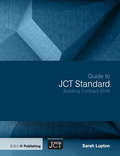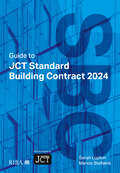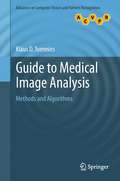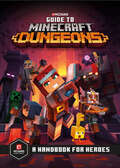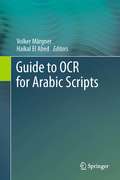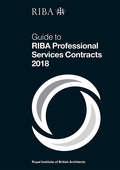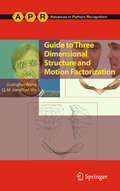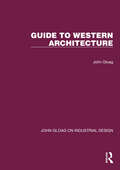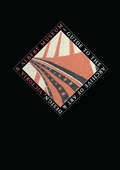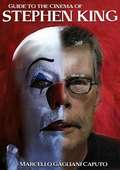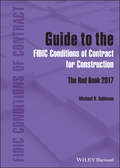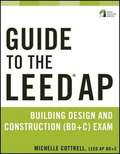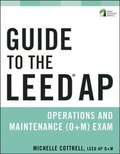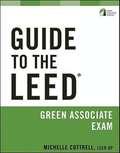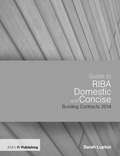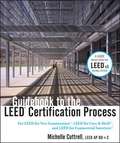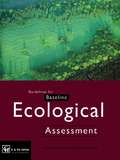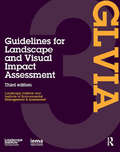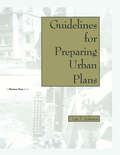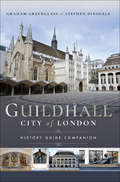- Table View
- List View
Guide to JCT Minor Works Building Contract 2024
by Sarah Lupton Manos StellakisThe latest edition of the JCT guide series provides an indispensable resource for architects navigating the JCT Minor Works Contract suite 2024. It offers a clear, practical breakdown of every provision, procedure and supplementary condition, comparing obligations under both the Minor Works and Minor Works with Contractor’s Design contracts.This guide equips you to handle on-site contractual challenges with confidence, supported by the latest case law and legislative updates.Key features of the 2024 edition: Detailed analysis of the JCT Minor Works Building Contract 2024, explaining every update. Coverage of recent legislative changes, including the Building Safety Act, Building Regulations Part 2A and Procurement Act 2023. Case law updates on key topics, such as design liability, concurrent delay, practical completion, liquidated damages and more. Comparative insights on NEC4 and RIBA Building Contracts, offering broader context for contract administration. New figures and tables, designed to enhance clarity and usability. Whether you’re an experienced architect or a student preparing for exams, this guide is designed to save you time and ensure you stay informed and compliant. With its easy-to-follow structure and expert analysis, it’s an essential tool for successfully managing JCT contracts.
Guide to JCT Standard Building Contract 2016
by Sarah LuptonGuide to JCT Standard Building Contract 2016 is a practical guide to the operation and administration of JCT’s SBC 2016 suite of building contracts (SBC/Q, SBC/AQ and SBC/XQ). All of the contracts’ provisions, procedures and conditions are organised and explained by subject, clearly distinguishing the different obligations due to various parties and the contractual issues arising during the course of a job - all backed up by the latest legislation and case law.
Guide to JCT Standard Building Contract 2024
by Sarah Lupton Manos StellakisThe latest edition of the JCT Guide series provides a practical, comprehensive overview of the 2024 JCT Standard Contract suite (SBC/Q, SBC/AQ, and SBC/XQ). It organises and explains all provisions, procedures, and conditions by subject, clearly outlining the obligations of various parties and addressing key contractual issues that may arise during a project-supported by the most recent legislation and case law.Key features of the 2024 edition:Detailed analysis of the JCT Standard Building Contract 2024, explaining every update. Coverage of recent legislative changes, including the Building Safety Act, Building Regulations Part 2A and Procurement Act 2023. Case law updates on key topics, such as design liability, concurrent delay, practical completion, liquidated damages and more. Comparative insights on NEC4 and RIBA Building Contracts, offering broader context for contract administration. New figures and tables, designed to enhance clarity and usability. This guide is not only an essential reference for busy practitioners but also a valuable resource for architecture and construction students preparing for their professional exams, requiring no prior knowledge of JCT contracts or law.
Guide to Medical Image Analysis
by Klaus D. ToenniesThis book presents a comprehensive overview of medical image analysis. Practical in approach, the text is uniquely structured by potential applications. Features: presents learning objectives, exercises and concluding remarks in each chapter, in addition to a glossary of abbreviations; describes a range of common imaging techniques, reconstruction techniques and image artefacts; discusses the archival and transfer of images, including the HL7 and DICOM standards; presents a selection of techniques for the enhancement of contrast and edges, for noise reduction and for edge-preserving smoothing; examines various feature detection and segmentation techniques, together with methods for computing a registration or normalisation transformation; explores object detection, as well as classification based on segment attributes such as shape and appearance; reviews the validation of an analysis method; includes appendices on Markov random field optimization, variational calculus and principal component analysis.
Guide to Minecraft Dungeons: A Handbook for Heroes (Minecraft)
by Mojang AB The Official Minecraft TeamWith insider info and tips from the experts at Mojang, this is the definitive guide to Minecraft Dungeons.It is a dark and dangerous time. Corrupted by the Orb of Dominance, the evil Arch-Illager has gathered a loyal following of Illagers. Together they have ravaged the land, enslaving the peaceful Villagers and forcing them to do their bidding. The Villagers are in desperate need of a hero, and you are their only hope. Within the pages of this valuable book, you will find strategies for fighting malicious mobs, observations about the perils of each dungeon and advice about how to get your hands on rare and powerful items. You will also learn how to work as part of a team to vanquish the Arch-Illager once and for all.The fate of us all lies in your hands, brave hero. The Arch-Illager&’s reign of terror ends now.
Guide to OCR for Arabic Scripts
by Volker Märgner Haikal El AbedThis Guide to OCR for Arabic Scripts is the first book of its kind, specifically devoted to this emerging field. Topics and features: contains contributions from the leading researchers in the field; with a Foreword by Professor Bente Maegaard of the University of Copenhagen; presents a detailed overview of Arabic character recognition technology, covering a range of different aspects of pre-processing and feature extraction; reviews a broad selection of varying approaches, including HMM-based methods and a recognition system based on multidimensional recurrent neural networks; examines the evaluation of Arabic script recognition systems, discussing data collection and annotation, benchmarking strategies, and handwriting recognition competitions; describes numerous applications of Arabic script recognition technology, from historical Arabic manuscripts to online Arabic recognition.
Guide to RIBA Domestic and Concise Building Contracts 2018
by Sarah LuptonThis latest title from the author provides comprehensive guidance to RIBA's two updated building contracts: the RIBA Domestic Building Contract 2018 and the RIBA Concise Building Contract 2018. Introducing the contracts' features and benefits and covering all aspects of their use, from choosing and forming the right one for your project to guiding the parties through all its various stages, the Guide has been expanded with increased assistance on choice of form, tendering and contract formation. Additional detail on role and liabilities of contract administrator has been added, along with a new section on practical completion and completion, including certification. Assuming no current knowledge of the law or contract administration, this acts as a standalone guide for new users of the RIBA contracts, as well as a valuable update for previous users. It is an ideal companion for anybody using the latest building contracts.
Guide to RIBA Professional Services Contracts 2018
by Ian DaviesThe 2018 edition of this guide explains how to use, understand and get the most out of the RIBA Professional Services Contracts, which have been updated from the RIBA Agreements 2010 (and 2012 revision). With guidance on how to choose, prepare and complete the right contract, it is an essential companion for anyone using these industry-standard forms. The guide is written for architects and consultants to help practitioners develop a greater understanding of the role and responsibility of each party to the agreement.
Guide to Three Dimensional Structure and Motion Factorization
by Guanghui Wang Jonathan WuThe problem of structure and motion recovery from image sequences is an important theme in computer vision. Considerable progress has been made in this field during the past two decades, resulting in successful applications in robot navigation, augmented reality, industrial inspection, medical image analysis, and digital entertainment, among other areas. However, many of these methods work only for rigid objects and static scenes. The study of non-rigid structure from motion is not only of academic significance, but also has important practical applications in real-world, nonrigid or dynamic scenarios, such as human facial expressions and moving vehicles. This practical guide/reference provides a comprehensive overview of Euclidean structure and motion recovery, with a specific focus on factorization-based algorithms. The book discusses the latest research in this field, including the extension of the factorization algorithm to recover the structure of non-rigid objects, and presents some new algorithms developed by the authors. Readers require no significant knowledge of computer vision, although some background on projective geometry and matrix computation would be beneficial. Topics and features: presents the first systematic study of structure and motion recovery of both rigid and non-rigid objects from images sequences; discusses in depth the theory, techniques, and applications of rigid and non-rigid factorization methods in three dimensional computer vision; examines numerous factorization algorithms, covering affine, perspective and quasi-perspective projection models; provides appendices describing the mathematical principles behind projective geometry, matrix decomposition, least squares, and nonlinear estimation techniques; includes chapter-ending review questions, and a glossary of terms used in the book. This unique text offers practical guidance in real applications and implementations of 3D modeling systems for practitioners in computer vision and pattern recognition, as well as serving as an invaluable source of new algorithms and methodologies for structure and motion recovery for graduate students and researchers.
Guide to Using the RIBA Plan of Work 2013
by Dale SinclairThe RIBA Plan of Work 2013 is the definitive framework for the contemporary building design and construction process. It provides a stage-by-stage model to assist all members of the project team to manage the process from inception to completion and beyond. This practical guide explains how the RIBA Plan of Work 2013 can be applied for optimal results in construction projects, revealing the Plan of Work as much more than just a project framework. It can be used as a tool to ensure best outcomes and guide thinking across a range of key themes including whole life costs, procurement routes, BIM, and social and environmental sustainability. With useful explanations of the various stages and technical terms, this book is packed with guidance and tips for using the Plan of Work to ensure genuinely integrated projects. Intended as complementary to the RIBA Plan of Work 2013 Online, the RIBA Job Book, and Assembling the Project Team, it is for construction professionals industry-wide, from architectural practices to clients and contractors, as well as students studying for their professional examinations.
Guide to Western Architecture
by John GloagOriginally published in 1958, A Guide to Western Architecture charts the origins of the system of architectural design that was perfected in Greece, follows its development under the Roman Empire and describes the achievements of the Byzantine architects. Passing through Romanesque to Gothic, the contributions made by Mediaeval builders to structure and design are recorded, and then the impact of the Renaissance on architecture, and its characteristic development in the different European countries. The transplanting of Renaissance ideas to the New World is covered, and finally the origins and nature of the new Western architecture occupy the last section of the book. The Appendix includes a list of the principal architects, and brief notes on their work, from the 5th century B. C. to the end of the Renaissance.
Guide to the Archive of Art and Design: Victoria and Albert Museum, London
by Elizabeth LomasThe Archive of Art and Design at the Victoria & Albert Museum contains Britain's foremost collection of primary source material relating to art and design, particularly of the twentieth century. Established in 1978, the Archive holds over 200 archives created by individual artists, craftspeople and designers and businesses and societies involved in the manufacture and promotion of art and design products. The Guide describes each archive in detail, offering information about its creator, its contents, and related sources held both inside and outside the V&A Museum. It is an invaluable reference text for everyone with an interest in studying British art and design.
Guide to the Cinema of Stephen King
by E. S. Dempsey Marcello Gagliani CaputoFew writers have managed to affect the cinema as much as Stephen King. From the '70s until today, almost all of his novels have been brought to the big screen or television, an indication of King's extraordinary ability to tell stories that are just made to be transformed into images. Directors like Brian De Palma, Stanley Kubrick, Rob Reiner and Frank Darabont have ventured into adaptations of King's writings, in some cases obtaining resounding success. Guide to the Cinema of Stephen King recounts the genesis of all the films (or TV series) adapted from King's works and analyzes them from the point of view of a film critic. From "Carrie" to "The Shining", on through "It" and "Misery", up to the recent television series "Under the Dome", this book is a veritable bible for fans who will find anecdotes, interesting facts, and detailed critical analysis of Kingian films.
Guide to the FIDIC Conditions of Contract for Construction: The Red Book 2017
by Michael D. RobinsonEnables readers to easily understand the contract to enable better compliance and efficiency Guide to the FIDIC Conditions of Contract for Construction: The Red Book 2017 helps the reader overcome some of the difficulties encountered on a typical international construction project using the FIDIC Construction Contract 2nd Edition (the 2017 Red Book), by summarizing the activities and duties of those involved, and crystallizing the requirements of the contract. To aid in reader comprehension, the text explains clauses in the sequence they appear in the contract, but also in the order they happen in real time on site. It further provides practical guidance in a concise manner, and in straightforward, jargon-free language. It is a highly practical resource for use during the project, rather than a legal review of the contractual requirements, ensuring readers are fully conversant with the revised requirements and procedures mandated by the 2017 edition of the contract. Guide to the FIDIC Conditions of Contract for Construction: The Red Book 2017 includes: A review of the duties and responsibilities of the three parties, the Employer, the Engineer and the Contractor, engaged on a FIDIC-based Contract A review of the flow of documentation and instructions which is to be provided by one party to another party throughout the contract period Practical guidelines are provided for the avoidance of disputes and delays in order that contracts are completed as plannedGuide to the FIDIC Conditions of Contract for Construction: The Red Book 2017 is a practical and highly useful resource for engineers, consultants, project managers, and others who are engaged in the site management of international projects using the FIDIC Construction Contract, along with those involved in contractual administration on behalf of the client.
Guide to the LEED AP Building Design and Construction (BD&C) Exam
by Michelle CottrellIdeal for architects, engineers, or contractors seeking the LEED Building Design & Construction (BD&C) credential, the book is a clearly organized study guide that includes sample quizzes throughout at the end of each section. Authored by an expert who teaches seminars on LEED BD&C to professionals, this LEED exam prep book stands out from its competitors in its engaging and stimulating approach. Material includes include drawings, charts, and diagrams to help the reader visually understand the concepts.
Guide to the LEED AP Operations and Maintenance (O+M) Exam
by Michelle CottrellHere is the ideal guide for understanding and preparing for the LEED AP O+M exam. Written by an expert who is a LEED consultant and partner at Green Education Services--a premier LEED exam preparation provider--Guide to the LEED AP Operations + Maintenance (O+M) Exam engages readers by breaking down difficult concepts in sustainable design and engineering in a clearly organized, straightforward manner that helps streamline the learning process. Covering the detailed concepts of the LEED for Existing Buildings: Operations + Maintenance green building rating system, this book is an all-inclusive resource for achieving successful results on the LEED AP O+M exam.
Guide to the LEED Green Associate Exam
by Michelle CottrellProven strategies to pass the LEED® Green Associate exam Here is the ideal study guide for understanding and preparing for the LEED® Green Associate exam. Written by an expert who is a LEED consultant and partner at Green Education Services-a premier LEED exam preparation provider-Guide to the LEED® Green Associate Exam engages readers by breaking down difficult concepts in sustainable design and engineering in a clearly organized, straightforward manner that helps streamline the learning process. Serving as a valuable resource for anyone looking for the challenging LEED Green Associate credential, Guide to the LEED® Green Associate Exam features: · A thorough overview to understanding the LEED certification process · A collection of sample test questions and study tips to reinforce learned material · An accessible and stimulating approach that fosters quicker retention · A set of strategies for summarizing critical information and details more effectively · A wealth of material that includes drawings, charts, and diagrams to help understand concepts visually · A total of 128 sample flashcards that allow you to study on the go! Covering basic knowledge of green design, construction, and operations for professionals who want to demonstrate green building expertise in nontechnical fields of practice, this book is the ultimate companion for achieving successful results on the LEED Green Associate exam.
Guide to the LEED Green Associate V4 Exam
by Michelle CottrellPrepare for the LEED Green Associate v4 exam with an expert who has been there - and passed!Guide to the LEED Green Associate V4 Exam is a comprehensive study guide for the LEED Green Associate v4 exam. Written by a LEED expert and consultant who actually passed the exam, this guide provides a first-hand account of preparation strategies that work. The book is designed to work with how people study, organized for quick navigation, with sample questions and flashcards throughout. The companion website offers additional study aids, including more sample test questions and flashcards. The book covers all topics and principles included on the exam, and provides all the information necessary to pass.Passing the LEED Green Associate v4 exam is the only way to get the Green Associate credential, so a complete, comprehensive study guide is essential. The Guide to the LEED Green Associate Exam has been updated specifically to align with the most current version of the exam. Topics include:The three tiers of the credentialing processConcepts and processes of sustainable designLEED design strategies and technologiesHow and what to study for the examBeyond just providing information, this book offers the insight of someone who's been there, and can manage expectations and eliminate surprises. Motivating, engaging, and packed with expert advice, the Guide to the LEED Green Associate Exam helps eager professionals prepare for - and pass - the LEED Green Associate v4 exam.
Guide to the RIBA Domestic and Concise Building Contracts 2014
by Sarah LuptonThis latest title from Sarah Lupton, best-selling author of construction contract guides, provides comprehensive guidance to the RIBA’s two new building contracts: the RIBA Domestic Building Contract 2014 and the RIBA Concise Building Contract 2014.Introducing the contracts’ features and benefits and covering all aspects of their use, from choosing and forming the right one for your project to guiding the parties through all its various stages, the Guide serves as the definitive introduction and an invaluable desktop reference for the busy contract administrator. Written in plain English to complement the RIBA Building Contracts themselves, the Guide assumes no prior knowledge of construction law or contracts; it is therefore also the ideal reference book for construction students on the threshold of undertaking their professional examinations.
Guidebook to the LEED® Certification Process
by Michelle CottrellProven Strategies for Getting a Project LEED® Certified Here is the ideal guide for architects, engineers, interior designers, project managers, facility managers, and building owners for understanding the project certification process for the Leadership for Energy and Environmental Design (LEED?) for New Construction and Major Renovations (LEED NC), LEED for Core & Shell (LEED CS), and LEED for Commercial Interiors (LEED CI) rating systems of the U. S. Green Building Council (USGBC?). Written by an expert who is the President of Design Management Services, a LEED consulting firm?Guidebook to the LEED Certification Process engages readers by outlining the steps, roles, and responsibilities of the team members in a straightforward, chronological manner that helps streamline the certification process. With the release of the LEED v3 rating systems and a new version of LEED-Online, the Guidebook to the LEED Certification Process helps project teams to streamline the project team efforts and outlines the role of the LEED consultant and project administrator. Written for LEED AP professionals and building owners that need guidance navigating a project through the process, this book outlines each step in the design and construction phases including programming and post-occupancy. Serving as a valuable resource for anyone seeking information on how to get a project LEED certified, Guidebook to the LEED Certification Process features: An overview of the integrative design process. Understanding the role of a LEED consultant. How to build a successful team for a project pursuing LEED certification. How to register a project with Green Building Certification Institute (GBCI). Common pitfalls to avoid during the LEED certification process. Checklists to use during design and construction to keep the team on track.
Guidelines for Baseline Ecological Assessment
by The Institute of Environmental AssessmentThese best practice guidelines present the type and level of detail required for describing and evaluating the ecological baseline of an environmental assessment. These assessments are vital in determining whether or not there are issues of ecological importance for a site or proposed development and are an essential component of the environmental impact assessment process.
Guidelines for Landscape and Visual Impact Assessment
by Landscape Institute I.E.M.A.Landscape and Visual Impact Assessment (LVIA) can be key to planning decisions by identifying the effects of new developments on views and on the landscape itself. This fully revised edition of the industry standard work on LVIA presents an authoritative statement of the principles of assessment. Offering detailed advice on the process of assessing the landscape and visual effects of developments and their significance, it also includes a new expanded chapter on cumulative effects and updated guidance on presentation. Written by professionals for professionals, the third edition of this widely respected text provides an essential tool for landscape practitioners, developers, legal advisors and decision-makers.
Guidelines for Preparing Urban Plans
by Larz AndersonWhile many authors have written about what urban plans should contain and how they should be used, this comprehensive book leads you step by step through the entire plan preparation process. Citing examples from across the country, Larz Anderson shows how to prepare, review, adopt, and implement urban plans. He explains how to identify public needs and desires, analyze existing problems and opportunities, and augment long-range general plans with short-range district and function plans. Anderson presents these guidelines as tasks. For each task, he explains the rationale behind it, recommends a procedure for completing it, and identifies the expected results. Throughout, Anderson encourages improvisation — he urges planners to adapt the guidelines to meet local needs. Excerpts from recently adopted general plans illustrate Anderson's points and provide examples of variations even within his recommendations. A related glossary gives comprehensive definitions to words that, though not technical, have meanings specific to the urban plan.
Guides to the Coinage of the Ancient World: The Hellenistic World
by Peter ThonemannCoinage is one of our key sources for the rich and fascinating history of the Hellenistic world (323–31 BC). This book provides students of the period with an up-to-date introduction to Hellenistic gold, silver and bronze coins in their cultural and economic contexts. It also offers new perspectives on four major themes in contemporary Hellenistic history: globalisation, identity, political economy and ideology. With more than 250 illustrations, and written in a lucid and accessible style, this book sheds new light on the diverse and multicultural societies of the Hellenistic world, from Alexander to Augustus. The author assumes no prior knowledge of Hellenistic history, and all Greek and Latin texts are translated throughout.
Guildhall - City of London: History Guide Companion
by Graham Greenglass Stephen DinsdaleThis is the first ever comprehensive history, guide and companion to the Guildhall, City of London.After the Romans deserted Londinium, where and when does Londons history restart? The answer lies within the highly visible, but rarely seen, ceremonial centre of the City of London: Guildhall.This fascinating complex of government buildings is central to Londons development, from Saxon times to the 21st century. It is the scene of royal banquets and historic trials, home to one of Londons finest art galleries and archive to the nations most comprehensive library of London books.Roman Londons only amphitheatre lies beneath, visible today and publicly accessible for the first time in seventeen hundred years. The City of London Police Museum relocated in 2016 to a larger, newly designed, accessible space within Guildhall Library.A history of Guildhall was last published in the 1920s. It was heavily bombed in 1940 and this will be the first book to record Guildhalls remarkable architectural and cultural resurrection since the end of the war. Photographs and images previously unpublished will be included and for the first time this book will also feature a comprehensive guide to Guildhalls many publicly accessible areas.Only one British building hosts banquets for British monarchs and visiting heads of state: Guildhall. Only one London building has a continuous story since Roman London: Guildhall. Only one building has governed the City and still directs its future: Guildhall. This illustrated history and companion to one of Londons most important and oldest buildings will prove indispensible to all interested in Londons history.

